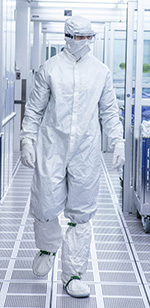SPONSORED POST
It has been estimated that 80% of the contaminants found in a typical cleanroom originate from people.1 Given the inherently non-sterile nature of human beings, this is hardly surprising.
The human scalp, for instance, contains about one million microorganisms per square centimetre.2 And these organisms can spread around with alarming ease—in fact, people routinely introduce contaminants into their immediate environment just by talking or moving around. The more physically active they are, the more pollutants they shed.
But cleanroom managers are not just handling threats to sensitive materials caused by humans; they must also deal with hazards that can endanger the health of their personnel.
Take arc flashes for example. Worn conductors, loose wires, or (most frequently) human oversight can create a devastating three-phase arc flash that reaches 35,000 °F (19,426 °C) in under one-thousandth of a second. Arc flash incidents sometimes result in fatal injuries; even less serious episodes often leave victims with damaged eyesight, burned skin, and other lasting impairments.
All of this is certainly a lot to contend with, but fortunately, cleanroom operators have access to appropriate and effective attire and accessories to help them maintain a safe and secure workplace environment.
This specialised cleanroom apparel has a dual function—it enables personnel to shield themselves against hazardous laboratory phenomena and prevent contaminants from harming valuable products.

Essential elements of cleanroom apparel
Cleanroom apparel consists of various pieces that, when donned correctly, form a "suit" that covers most, or all, of the wearer's body. A standard suit will generally consist of the following components:
- Coverall
- Face mask
- Goggles
- Hood
- Gloves
- Boot or shoe covers
It's common knowledge that all cleanroom clothing isn’t created equal or equally "suited" for all labs. You need apparel that is capable of neutralising the full spectrum of potential issues that can arise in your unique facility. For instance, the requirements of Class 1 (ISO 3) cleanroom are substantially stricter than those of Class 1,000 (ISO 6) lab.
Crucial Characteristics of Effective Cleanroom Apparel
Comfortable, tear-resistant, non-linting fabric (woven or non-woven) is essential for preventing contamination of the cleanroom. Small rips in clothing can expel pollutants into the air, while common lint can spell disaster for sensitive materials.
In addition, cleanroom apparel must include certain features to protect personnel from the various dangers of these environments. There are several important safety features you need to look for:
- Arc flash resistance: If your cleanroom contains equipment capable of producing an arc flash, then you are required by guidelines of the Occupational Safety and Health Administration—specifically OSHA § 1910.269(l)(8)(iii) and OSHA § 1910.335(a)(1)(v)—to ensure that your employees wear clothing that can protect against this threat. Polyester, nylon, rayon, or acetate clothing is unacceptable. Look for apparel that has been specifically created to withstand arc flashes. To resist arc flashes effectively, cleanroom apparel must be designed for flame retardance (Nomex® filaments are excellent for this).
- Static dissipation: Static electricity is capable of wreaking havoc on delicate microprocessors and medical devices, even when discharges are extremely mild (under 100 V), and this phenomenon can also trigger arc flashes as well. Look for apparel with electrostatic discharge (ESD) characteristics, such as anti-static carbon fibres woven into a grid-like pattern. This sort of clothing will not generate or hold static electricity.
- High-density material: You should use apparel that can resist fluids and bacteria so that they cannot soak through to the wearer's skin; it should provide a high level of heat protection as well.

Jerry Martin, VP Sales & Marketing
Before selecting apparel for employee use, you should ideally conduct risk and hazard analysis to gain a proper understanding of the vulnerabilities within your cleanroom. This will give you the information you need to make the right choice.
Jerry Martin
Jerry Martin is the Vice President of Sales & Marketing at Prudential Overall Supply and Prudential Cleanroom Services, a trusted name in the cleanroom industry, providing cleanroom apparel services since 1960. PCS specializes in cleanroom garment processing services for aseptic, particulate, & ESD controlled environments. Prudential also provides cleanroom laundry and apparel service programs.
Sources:
2. www.ivtnetwork.com/article/people-cleanrooms-understanding-and-monitoring-personnel-factor
